Summary
Revista Brasileira de Ginecologia e Obstetrícia. 2000;22(1):49-54
DOI 10.1590/S0100-72032000000100009
Purpose: to compare patients with genuine stress incontinence (GSI) who were submitted to a pelvic floor exercise program (PFEP) with those who were submitted to a pelvic floor electrical stimulation (PFES). Methods: fourteen GSI patients, with age between 31-64 years, participated in the study. They were divided into two groups of 7 each. PFEP or PFES was performed for 10 days. The women were evaluated at the first consultation and reevaluated after the ten-day treatment by only one physical therapist. For the statistical analysis nonparametric tests were used. Results: all had a partial or a total improvement of the GSI after the treatment, considering the subjective and objective analysis of the research. Conclusion: both PFEP and PFES showed to be effective to treat GSI, although PFEP showed a tendency to be the better treatment.

Summary
Revista Brasileira de Ginecologia e Obstetrícia. 2000;22(1):43-48
DOI 10.1590/S0100-72032000000100008
Purpose: to analyze the prevalence of genuine urinary incontinence (GUI) recurrence, after at least two years of follow-up, in different surgical techniques used for its correction. Patients and Methods: fifty-five patients with diagnosis of GUI, submitted to surgery for its repair at the Serviço de Ginecologia e Obstetrícia do Hospital de Clínicas de Porto Alegre from 1992 to 1996 and whose post-surgical follow-up was superior to 2 years were divided into three groups according to the surgical approach: Kelly-Kennedy (n = 24), Burch (n = 23) and Marshall-Marchetti-Krantz (n = 8). Results: there were no differences regarding recurrence rate, age at surgery and at recurrence time, estrogen therapy, number of pregnancies and vaginal delivery (p>0.05). Although posterior perineoplasty was more prevalent in the Kelly-Kennedy group, it did not influence the recurrence rate. The group submitted to the Burch approach had more years of menopause at the time of surgery. Conclusion: the recurrence rates of urinary incontinence comparing the three different techniques (Kelly-Kennedy, Burch and Marshall-Marchetti-Krantz) were, respectively, 29.2, 39.1 and 50%, which did not differ statistically. Considering the potential confusional bias for urinary stress incontinence, they did not differ among the groups. Nevertheless, we noticed that all women who had previous surgery presented recurrence of incontinence.
Summary
Revista Brasileira de Ginecologia e Obstetrícia. 2000;22(1):27-32
DOI 10.1590/S0100-72032000000100005
Purpose: to identify and quantify the underreporting of maternal mortality, from death certificates (DC) in Campinas, São Paulo, from 1992 to 1994. Methods: a total of 216 DC whose causes of death were maternal (declared and/or presumed) were selected among the 1032 DC of 10 to 49-year-old women. A complementary investigation was performed on hospital records, at the death verifying units, and in households. Results: eight additional maternal deaths were identified among the 204 DC with presumed maternal death. This corresponded to an underreporting rate of 40% or to a correction factor of 1.67 for the official MMR. The first cause of underreporting was abortion (71.5% or 05/07) and indirect maternal deaths represented the second cause (66.6% or 02/03). Conclusions: the death certificate cannot be considered the only source to identify maternal death. Complementary investigation of the presumable causes of maternal death should be performed. Legislation, social and religious factors might influence the underreporting of abortion as the cause of maternal death.
Summary
Revista Brasileira de Ginecologia e Obstetrícia. 2000;22(1):19-26
DOI 10.1590/S0100-72032000000100004
Purpose: to evaluate gestational and delivery complications as risk factors for perinatal death. Methodology - Patients: the cases (perinatal deaths) were identified among a total of 3,031 deliveries from the maternity of the Rio de Janeiro State Military Police. Methods: the study design was a nested case-control one. Cases (n = 82) were perinatal deaths with a minimum gestational age of 28 weeks or a weight of 1,000 g. Controls (n = 246) were live babies for the first week of life. The analysis was made in three steps: univariate, stratified and multivariate (logistic regression). Results: the gestational complications showed an odds ratio of 4.21 and the delivery complications, 5.26. The newborn weight showed an OR = 0.999 per gram over 1,000 g weight. The gestational age showed an OR = 0.729 per week of gestation over 28 weeks. Conclusions: the gestational complications and the delivery complications were important risk factors for perinatal death. The gestational age and the weight of the newborn were important protective factors.

Summary
Revista Brasileira de Ginecologia e Obstetrícia. 2000;22(4):229-233
DOI 10.1590/S0100-72032000000400007
Purpose: to evaluate the effects of hormone replacement therapy on the body mass index of postmenopausal women. Methods: for this purpose, 166 users and 136 non-users of hormone replacement were evaluated retrospectively during a period of three years. All women were assisted at the Menopause Outpatient Clinic of CAISM - UNICAMP, where the variations in this parameter were evaluated at the end of each year in relation to the initial parameters. The data analysis was performed through chi² test, Student's t test, and Mann-Whitney test. Results: we observed no significant variations in the body mass index, when comparing users and non-users during the three years of observation. Conclusion: hormone replacement therapy did not produce changes in this parameter in women properly assisted during its use.
Summary
Revista Brasileira de Ginecologia e Obstetrícia. 2000;22(4):225-228
DOI 10.1590/S0100-72032000000400006
Purpose: to analyze the frequency of glove perforation during gynecologic surgeries. Methods: a prospective study of 454 gloves used in 65 surgeries by the water pressure method. Results: of a total of 454 gloves, 54 (11.9%) had perforations. Comparison with the control group showed p<0.05 (chi² test), 1 (1.7%) perforation in 60 gloves tested. Of the total of gloves used in 65 surgeries, 29 (44.6%) had perforations, 44 (81%) had one perforation and 10 (19%) had more than one perforation. The two most common sites of perforations were the index finger, 20 (29.5%) and the thumb, 14 (25.9%). Perforation was predominant in the left hand (72.1%). The surgeons were the members of the team with the greatest number of glove perforations. Total hysterectomy was the most frequent surgery in which glove perforations occurred (50% of the cases). Conclusion: the glove perforations occurred with relatively high frequency during gynecologic surgeries. The index finger of the left hand proved to be the most affected region. Among the members of the team, the highest percentage of glove perforations occurred in those of the surgeons. Total hysterectomy had the highest perforation rate.
Summary
Revista Brasileira de Ginecologia e Obstetrícia. 2000;22(4):209-216
DOI 10.1590/S0100-72032000000400004
Purpose: to observe the circadian pattern of blood pressure variation in normotensive and hypertensive pregnant women, assessing the occurrence of nocturnal blood pressure decrease, as well as the compliance with the method and possible complications. Methods: the blood pressure measurement was carried out in seventeen normotensive and fourteen hypertensive pregnant women at the Hospital das Clínicas of UFMG. Blood pressure was measured on two different occasions during gestation using the oscillometric technique to compare both groups. Results: in both groups nocturnal decrease in blood pressure as well as an increase in pressure levels was observed as pregnancy advanced. No significant complications were seen and they did not interfere with compliance which was 100%. Conclusions: the ambulatory blood pressure measurement is useful to evaluate pressure variation in normotensive and hypertensive pregnant women confirming the gradual increase in blood pressure throughout pregnancy and the nocturnal physiologic decrease which does not depend on maternal pressure levels.

Summary
Revista Brasileira de Ginecologia e Obstetrícia. 2000;22(1):7-12
DOI 10.1590/S0100-72032000000100002
Purpose: to compare the capacity of diagnosing oligohy-dramnios by ultrasound using different measures of the maximum pool depth of amniotic fluid in comparison to the amniotic fluid index among normal pregnant women from the 36th to the 42nd week of gestation. Methods: a descriptive study of diagnostic validity was perfomed, on 875 normal pregnant women who were studied through routine obstetric ultrasound examinations, including the measure of the maximum pool depth for the diagnosis of oligohydramnios, using the amniotic fluid index as the gold standard. The data were analyzed through sensitivity and specificity of the maximum pool depth of amniotic fluid using 10, 20 and 30 mm cut-offs, in comparison to the amniotic fluid index values of the normal curve in percentiles 2.5 and 10 for different gestational ages. Results: the maximum pool depth had a poor sensitivity to diagnose oligohydramnios when 10 and 20 mm were used as cut-offs, and good sensitivity and specificity when 30 mm was used, in comparison to the amniotic fluid values in percentiles 2.5 and 10. The best sensitivity and specificity of the maximum pool depth were when found using a 30 mm cut-off in comparison to 2.5 percentile to diagnose oligohydramnios. Conclusions: the capacity to diagnose oligohydramnios by the measure of the maximum pool depth is satisfactory only with the cut-off of 30 mm